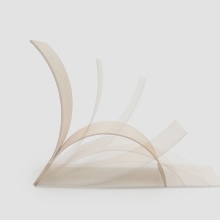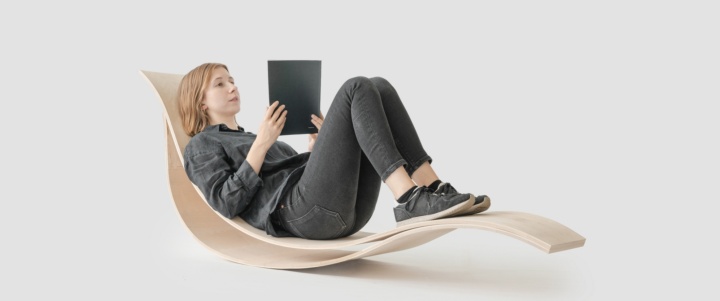Elegantly curved seating furniture that is delivered in a flat-pack and assumes its shape overnight all by itself – this may sound like a dream to those who ever puzzled over the assembly instructions from a furniture store. HygroShape is the first concept for furniture that makes this dream a reality. It relies on the shaping forces of nature and combines these with the possibilities of digitalization. It was developed by the team of Prof. Achim Menges at the Institute for Computational Design and Construction (ICD) at the University of Stuttgart.
With HygroShape, ICD researchers Dr. Dylan Wood and Laura Kiesewetter are exploiting an intrinsic property of wood that is known to every carpenter or joiner: The cell walls expand when wet and contract when drying, while the stiffness exactly correlates with the change in moisture content. If wood dries in an uncontrolled manner, this hygroscopic shrinkage causes undesirable deformation and the material warps. If you understand how the forces work, however, you can utilize them for achieving a specific change in shape that is driven by the material only – and which is completed silently, without human intervention, tools, or assembly instructions. Once the piece of furniture has assumed its shape, the parts interlock mechanically and, in this way, create stability.
conifer cones are the inspiration
The Stuttgart researchers copied the biological principle for the passive self-shaping process from, among other things, the cones of conifers. The cone scales consist of anisotropic fiber composites that form a bilayer. As long as the cone is alive, a high water content is maintained in this bilayer. After the cone has fallen off the tree, the scales dry out, slowly flex open, and release the seeds. Within the HygroShape concept, the researchers digitalize the physical-mechanical properties of such composite materials by means of finely tuned computer-aided design methods and compute a specific material syntax in order to prepare the material for the planned deformation sequence.
Based on this specific syntax, flat, multi-layered wooden parts are produced that have a sophisticated internal composition and a defined moisture content. Using a computer-aided design tool, the planks are then arranged in tailored configurations that control and coordinate the subsequent shaping process. By means of this physical coding, each piece, when flat, is programmed in such a way that a defined curved geometry will be created when the moisture content is reduced. Finally, the parts are sealed and transported to the end user, where they will be exposed to an environment that is significantly drier than the production environment which thus activates the shaping sequence.
The digital design allows the use of a range of natural materials with higher variability, while opening the door to a new design language. In fact, for several years now, furniture has often been transported in compact, flat packages for cost reasons and only assembled on site, which limits the scope of furniture design to straight and angular shapes. By contrast, the unique material behavior of a HygroShape part allows elegant curves and slim surfaces, and standard angle and metal fittings are not required. “The self-shaping process by its nature leads to an honest and clean design,” say Prof. Achim Menges and Dylan Wood. “The result is a stable and yet flexible structure that dynamically interacts with the body.”
The pieces of furniture that are manufactured using the HygroShape technology – a lounge chair and a chaise lounge – are still unique specimens. But with their spin-off company hylo-tech (www.hylo.tech), the researchers want to test the marketability of the technology on the basis of a limited series. The project received funding from the University of Stuttgart’s knowledge and technology fund and was also supported by the companies Henkel AG, Schönweiler GmbH, and Gettylab.
Expert Contact:
Prof. Achim Menges, Dr. Dylan Wood, Laura Kiesewetter, University of Stuttgart, Institute for Computational Design and Construction, Phone +49 711 685 827 86, E-Mail



